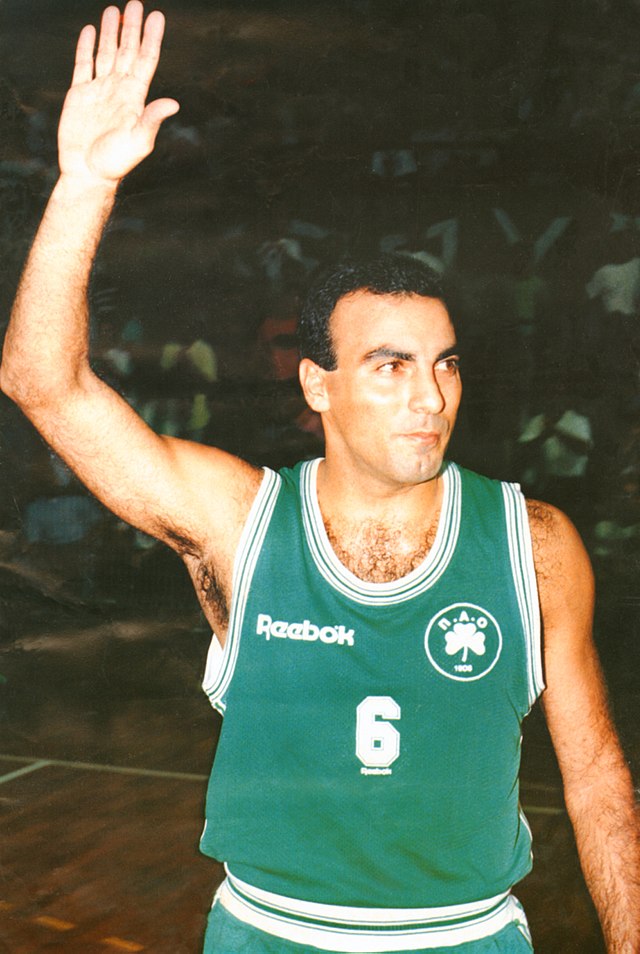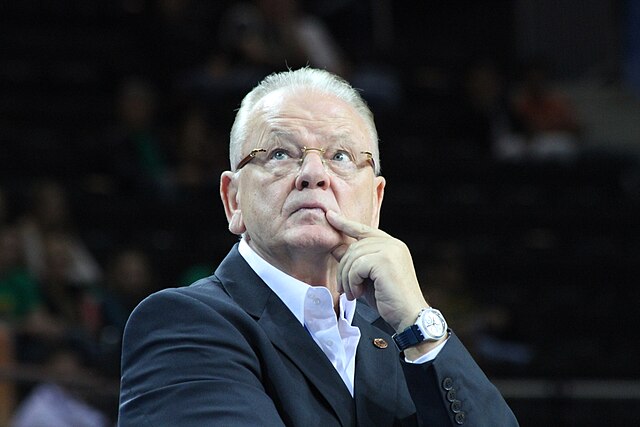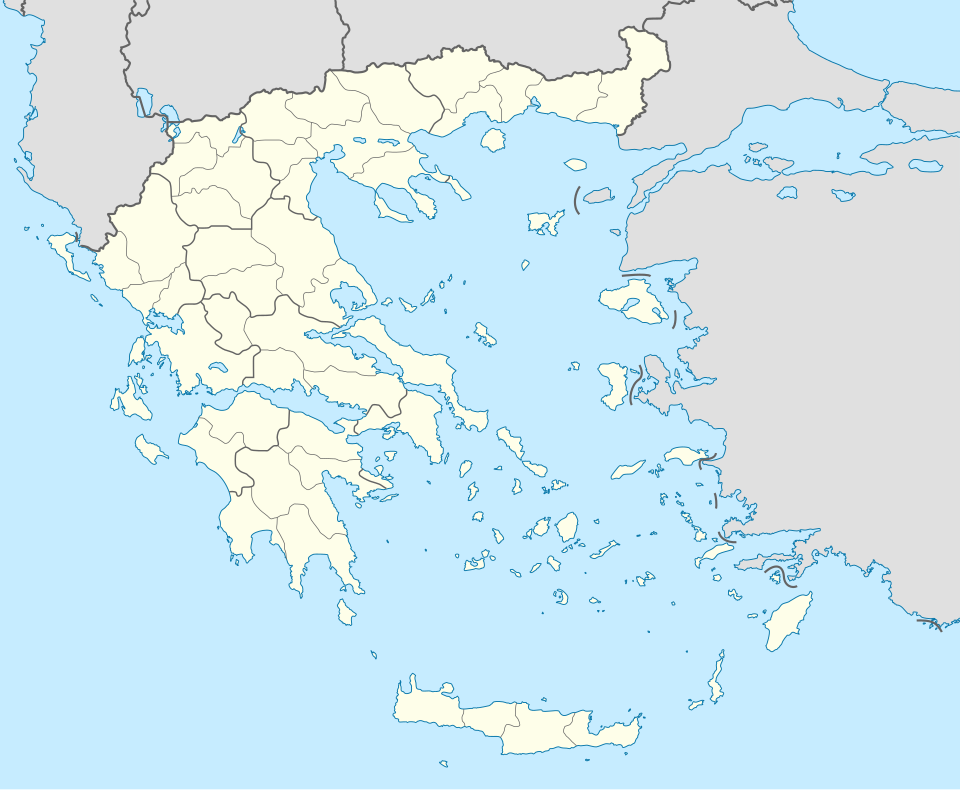Greek Basketball League
Professional basketball league in Greece From Wikipedia, the free encyclopedia
The Greek Basketball League (abbreviated as GBL), and also known as the Stoiximan Greek Basketball League (GBL) for sponsorship reasons, is the first tier level professional basketball league in Greece. It is run by the Hellenic Basketball Association (abbreviated as HEBA; Greek: ΕΣΑΚΕ), under the legal authority of the Hellenic Basketball Federation (abbreviated as HBF; Greek: Ε.Ο.Κ.). Over the years, the league has previously been known by several different names, which have included: the Panhellenic Basketball Championship or Greek Basketball Championship, the Panhellenic Basketball First Category Championship (1st) (A) or Greek Basketball First Category Championship (1st) (A), the Greek Alpha National Basketball Category Championship (A), the Greek Alpha1 National Basketball Category Championship (A1), the HEBA Alpha1 (A1), and most recently, the Greek Basket League. The league's current official main sponsor is Stoiximan.
| Founded | 1927 |
|---|---|
| First season | 1927–28 |
| Country | Greece |
| Federation | HEBA |
| Confederation | FIBA Europe |
| Number of teams | 12 |
| Level on pyramid | 1 |
| Relegation to | A2 Basketball League |
| Domestic cup(s) | Greek Cup Greek Super Cup |
| International cup(s) | EuroLeague EuroCup FIBA Champions League FIBA Europe Cup |
| Current champions | Panathinaikos (40th title) |
| Most championships | Panathinaikos (40 titles) |
| All-time top scorer | Vassilis Spanoulis |
| Commissioner | Vangelis Galatsopoulos |
| TV partners | ERT |
| Website | esake.gr (Greek) |







The GBL is the highest-tier level of the Greek league system. The GBL plays under FIBA rules and currently consists of 12 teams, with each season's lowest-placed team being relegated to the A2 Basketball League, and then being replaced by the winner of the playoffs of that tier. The league runs from October to June, with teams playing 22 games each during the regular season, and the top 8 placed teams in the regular season standings then competing in the league's playoffs.[1] The first official Greek Basketball Championship was held in the 1927–28 season. The league held a competition in which the teams of the league played under a format with a nationwide schedule, for the first time, in the 1963–64 season. The league first held a playoff round in the 1986–87 season. The league first allowed foreign (non-Greek) players, in the 1988–89 season. The league first became a fully professional competition in the 1992–93 season, and that was also when its competition status was officially changed from the amateur category, to the professional category.
Historically, the GBL has been ranked as one of the top 3 level national domestic leagues in European basketball, since the league rankings began. For further information, see historical European national basketball league rankings, and European national basketball league rankings.
History
Summarize
Perspective
The first official regional club basketball tournament in Greece, took place in the year 1924.[2] While the first edition of the Greek basketball championship took place in the 1927–28 season, the first fully organized Greek basketball championship began. The league was originally organized by the Hellenic Amateur Athletic Association (SEGAS). There have been four different official championship eras. The first era was the Panhellenic Championship (Πανελλήνιο Πρωτάθλημα), which lasted from the 1927–28 to 1962–63 seasons, when the champions of every regional district played each other to decide the Greek Champion. The second era started in the 1963–64 season, when the A National Category (Α' Εθνική Κατηγορία), or Alpha National Category was founded.[3]
In 1969, the Hellenic Basketball Federation (E.O.K.) took over the duties of overseeing the competition, and did so until the year 1992. The third era of the championship existed between the 1986–87 and 1991–92 seasons, when the first division A1 National Category (Α1 Εθνική Κατηγορία), with a regular season and playoffs, and the second division A2 National Category (Α2 Εθνική Κατηγορία) were formed. The 1988–89 season, marked the first time that Greek Basket League teams were allowed to have foreign players on their rosters.[4]
The fourth era of the championship began in the 1992–93 season, when the Hellenic Basketball Association (HEBA) took over the competition and renamed the first division the HEBA A1 (ΕΣΑΚΕ Α1). The league was then renamed to Greek Basket League (Ελληνική Μπάσκετ Λιγκ), starting with the 2010–11 season.
The Greek League has been one of the most competitive basketball leagues in Europe through the years, and it was widely regarded as the second best national domestic league in the world, after only the NBA, in the 1990s decade. It currently ranks among the best national domestic leagues in the world (excluding the NBA), such as Liga ACB in Spain, VTB United League (counts as the domestic league for Russian clubs), and BSL in Turkey. Historically, the league has been ranked as one of the top 3 European national domestic leagues, along with Italy's Lega Basket Serie A and Spain's Liga ACB, under the historical European national basketball league rankings and European national basketball league rankings.
The league has several European historical basketball powers, which also belong to some of the most traditional European basketball clubs, especially Panathinaikos, Olympiacos, and AEK (which had great success in the 1960s), which are three of the most successful European basketball clubs of all time. Also, Aris, led by Nikos Galis, Panagiotis Giannakis, and Slobodan "Lefteris" Subotić, was the dominant Greek club, and one of the most powerful European teams in the 1980s. Other clubs that have had significant success throughout the history of Greek basketball, as well as success in European basketball, are PAOK and Panellinios. The first five aforementioned clubs (Panathinaikos, Olympiacos, AEK, Aris and PAOK), are also the most widely supported by fans in Greece.
Despite the championship having been contested 84 times, only nine different clubs have won it so far. The dominating club has usually been Panathinaikos, having claimed the championship 40 times. Since the foundation of the Alpha National Category in the 1963–64 season, only two teams have participated in every season of the competition, Panathinaikos and Aris.
Brand
Name
- Amateur era (1927–28 to 1991–92):
- 1927–28 to 1960–61: Panhellenic Championship
- 1961–62 to 1962–63: Panhellenic First Category Championship (1st) (A)
- 1963–64 to 1985–86: Alpha (A) National Category
- 1986–87 to 1991–92: Alpha1 (A1) National Category
- Professional era (1992–93 to present) :
- 1992–93 to 2011–12: HEBA Alpha1 (A1)
- 2012–13 to 2023–24: Greek Basket League
- 2024–25 to present: Greek Basketball League (GBL)
Sponsors
Logo
The main elements of the logo were changed in 2013.[5]
- 2012–2013
- 2013–2024
Regulations
Summarize
Perspective
The championship, in its current form, has been organized since the 1992–93 season by the Hellenic Basketball Association (HEBA), under the authority of the Hellenic Basketball Federation. The fully professional Greek basketball clubs compete in the first division championship, which is often colloquially called the "A1", in which 12 teams compete for the Greek National Championship. There is also a professional level second division championship that is run entirely by the Hellenic Basketball Federation, which is called the "A2", in which 16 teams compete for the second division crown. The bottom one place finishing team each year in the A1 division standings is relegated to the A2 division, due to poor performance. While conversely, the top one teams each year from the A2 division is promoted to the A1 division, due to good performance.
Club and arena standards
In order to compete in the Greek Basketball League, clubs must invest a minimum of €1 million on club operations per season. The minimum club budget per season is €800,000, and each club must also invest €200,000 into a league-wide fund that insures players get their full salaries. Most of the league's clubs invest more than the minimum requirements in each season.
Currently, Greek Basketball League clubs must play their home games in arenas with a seating capacity of at least 2,000 people, in order to play Greek domestic league games. Some Greek clubs have two arenas that they primarily use. One for domestic Greek League games, and one for European-wide games.
Greek clubs that play in European-wide competitions, such as the EuroLeague, the EuroCup, or the FIBA Champions League, must play their home games in those leagues in arenas that fit the arena standards of those leagues. Which are currently, a 5,000 seat minimum for the EuroLeague, and a 3,000 seat minimum for the EuroCup and FIBA Champions League.
Foreign players
Greek Basketball League teams were first allowed to have foreign (non-Greek) players on their rosters in the 1988–89 season.[6] Under the league's current foreign player rules, Greek Basketball League teams must have at least 6 players with Greek citizenship on their active 12-man game rosters. Each team is allowed to have up to 6 foreign (non-Greek) players on their active 12-man game roster.
Starting with the 2022–23 season, each team can have a total of up to 7 foreign players registered on its active league roster. However, every team is obliged to select only 6 of them for the 12 man game rosters, right before each game is started. Originally, that rotation of 6 of the 7 foreign players was not allowed to take place during the league's playoffs. However, it was ultimately decided that starting with the 2023–24 season, the aforementioned rotation of 6 out of the 7 foreign players on each team's roster, is also allowed in the league's playoffs.
However, there are no restrictions on the number of foreign players allowed by country of origin, or on the overall total number of foreign players allowed to be signed to a team's roster. Meaning that for example, any team in the league can sign any number of American players, Canadian players, or players from European countries, etc., that it wants to, and that any team in the league can sign as many foreign players overall to its roster as it wants to, but that they can only register 7 of them at a time to the active roster, and that they can only play 6 of them in any one game.[7]
Current clubs
The clubs for the 2024–25 season:
| Team | City | Arena | Capacity | Appearances in GBL |
|---|---|---|---|---|
| AEK | Athens | SUNEL Arena | 9,025 | 57 |
| Aris | Thessaloniki | Alexandreio Melathron Hall | 5,138 | 60 |
| Karditsa | Karditsa | Giannis Bourousis Indoor Hall | 3,500[8][9] | 1 |
| Kolossos Rodou | Rhodes (Faliraki) | Kallithea Palais des Sports | 3,400 | 17 |
| Lavrio | Lavrio | Lavrio Indoor Hall | 1,700 | 8 |
| Maroussi | Athens (Marousi) | Maroussi Saint Thomas Indoor Hall | 1,700 | 14 |
| Olympiacos | Piraeus | Peace and Friendship Stadium | 14,776[10] | 55 |
| Panathinaikos | Athens (Marousi) | O.A.C.A. Hall | 18,300[11] | 60 |
| Panionios | Athens (Nea Smyrni) | National Athletic Center Glyfada Makis Liougas | 3,500 (collapsible) 2,272 (permanent) |
47 |
| PAOK | Thessaloniki (Pylaia) | P.A.O.K. Sports Arena | 8,162[12] | 59 |
| Peristeri | Athens (Peristeri) | Peristeri Hall | 4,000 | 24 |
| Promitheas Patras | Patras (Proastio) | Dimitris Tofalos Arena | 5,500 | 7 |
Statistics
Summarize
Perspective
Title holders
|
|
|
Performance by club
| Titles | Champions | Years |
|---|---|---|
| 40 | Panathinaikos | 1945–46, 1946–47, 1949–50, 1950–51, 1953–54, 1960–61, 1961–62, 1966–67, 1968–69, 1970–71, 1971–72, 1972–73, 1973–74, 1974–75, 1976–77, 1979–80, 1980–81, 1981–82, 1983–84, 1997–98, 1998–99, 1999–2000, 2000–01, 2002–03, 2003–04, 2004–05, 2005–06, 2006–07, 2007–08, 2008–09, 2009–10, 2010–11, 2012–13, 2013–14, 2016–17, 2017–18, 2018–19, 2019–20, 2020–21, 2023–24 |
| 14 | Olympiacos | 1948–49, 1959–60, 1975–76, 1977–78, 1992–93, 1993–94, 1994–95, 1995–96, 1996–97, 2011–12, 2014–15, 2015–16, 2021–22, 2022–23 |
| 10 | Aris | 1929–30, 1978–79, 1982–83, 1984–85, 1985–86, 1986–87, 1987–88, 1988–89, 1989–90, 1990–91 |
| 8 | AEK | 1957–58, 1962–63, 1963–64, 1964–65, 1965–66, 1967–68, 1969–70, 2001–02 |
| 6 | Panellinios | 1928–29, 1938–39, 1939–40, 1952–53, 1954–55, 1956–57 |
| 2 | Iraklis | 1927–28, 1934–35 |
| PAOK | 1958–59, 1991–92 | |
| 1 | Near East | 1935–36 |
| Athens University | 1936–37 |
A1 Finals
Basket League/A1 finals participation by club (through 2024)
| Club | W | L | Total |
|---|---|---|---|
| Panathinaikos | 19 | 8 | 27 |
| Olympiacos | 10 | 14 | 24 |
| Aris | 4 | 0 | 4 |
| PAOK | 1 | 6 | 7 |
| AEK | 1 | 3 | 4 |
| Panionios | 0 | 1 | 1 |
| Maroussi | 0 | 1 | 1 |
| Promitheas Patras | 0 | 1 | 1 |
| Lavrio | 0 | 1 | 1 |
Number of seasons in the Panhellenic Championship (1927–28 to 1962–63)
The number of times that clubs participated in the league's original format, the Panhellenic Championship.
|
|
|
|
Number of seasons in the A and A1 National Categories by club (1963–64 – 2023–24)
The number of times that clubs participated in the top A National Category, while it existed from the 1963–64 season to the 1985–86 season. As well as the number of times that clubs have participated in the top A1 National Category, since it began with the 1986–87 season. Only two clubs, Panathinaikos and Aris, have played in the top division every year since its formation.
- 1963–64 to 1985–86: Alpha (A) National Category
- 1986–87 to 1991–92: Alpha1 (A1) National Category
- 1992–93 to 2009–10: HEBA Alpha1 (A1)
- 2012–13 to 2023–24: Greek Basket League
- 2024–25 to present: Greek Basketball League (GBL)
Number of seasons in the top-tier level Greek Basket League in total (1928 to 2023–24)
The total number of times that each club has played in the top-tier level Greek Basket League, through all of its different league formats.
- 1927–28 to 1960–61: Panhellenic Championship
- 1961–62 to 1962–63: Panhellenic First Category Championship (1st) (A)
- 1963–64 to 1985–86: Alpha (A) National Category
- 1986–87 to 1991–92: Alpha1 (A1) National Category
- 1992–93 to 2009–10: HEBA Alpha1 (A1)
- 2010–11 to 2023–24: Greek Basket League
- 2024–25 to present: Greek Basketball League (GBL)
|
|
|
|
Best regular season records in the history of the A and A1 National Categories (1963–2024)
- 1963–64 to 1985–86: Alpha (A) National Category
- 1986–87 to 1991–92: Alpha1 (A1) National Category
- 1992–93 to 2009–10: HEBA Alpha1 (A1)
- 2010–11 to 2023–24: Greek Basket League
- 2024–25 to present: Greek Basketball League (GBL)
A and A1 National Category (1963–2024)
| Season | Team | Regular season Record | Playoff record | Final Record (Including playoffs) | Final Season Result |
|---|---|---|---|---|---|
| 1985–86 | Aris | 26-0 | — | 26-0 | Champion |
| 1967–68 | AEK | 22-0 | — | 22-0 | Champion |
| 1975–76 | Olympiacos | 22-0 | — | 22-0 | Champion |
| 1986–87 | Aris | 18-0 | 3-0 | 21-0 | Champion |
| 1987–88 | Aris | 18-0 | 3-0 | 21-0 | Champion |
| 2017–18 | Panathinaikos | 26-0 | 8-2 | 34-2 | Champion |
| 1979–80 | Panathinaikos | 16-0 | 12-2 | 28-2 | Champion |
| 2010–11 | Olympiacos | 26-0 | 6–3 | 32–3 | Finalist |
The best overall season records of the HEBA A1 (1992–2024)
| Season | Club | Regular season Record | Playoff record | Final Record | Final Season Result |
|---|---|---|---|---|---|
| 2017–18 | Panathinaikos | 26–0 | 8–2 | 34–2 | Champion |
| 2009–10 | Panathinaikos | 25–1 | 8–1 | 33–2 | Champion |
| 2014–15 | Olympiacos | 25–1 | 8–1 | 33–2 | Champion |
| 2015–16 | Olympiacos | 25–1 | 8–1 | 33–2 | Champion |
| 2013–14 | Panathinaikos | 25–1 | 8–2 | 33–3 | Champion |
| 2023–24 | Panathinaikos | 26–1 | 7–2 | 33–3 | Champion |
| 2005–06 | Panathinaikos | 24–2 | 8–0 | 32–2 | Champion |
| 2018–19 | Panathinaikos | 24–2 | 8–0 | 32–2 | Champion |
| 2010–11 | Panathinaikos | 24–2 | 8–1 | 32–3 | Champion |
| 2010–11 | Olympiacos | 26–0 | 6–3 | 32–3 | Finalist |
| 2006–07 | Panathinaikos | 24–2 | 8–2 | 32–4 | Champion |
| 2021–22 | Olympiacos | 23–1 | 8–0 | 31–1 | Champion |
| 2011–12 | Olympiacos | 23–1 | 8–2 | 31–3 | Champion |
| 2008–09 | Olympiacos | 25–1 | 6–3 | 31–4 | Finalist |
| 2016–17 | Panathinaikos | 25–1 | 6–3 | 31–4 | Champion |
| 2022–23 | Olympiacos | 22–0 | 8–1 | 30–1 | Champion |
Greek basketball clubs in European and worldwide competitions
Awards and players
All-time stats leaders
The all-time stats leaders of the HEBA fully professional level era Greek Basketball League, from the 1992–93 season to the present. These are the officially recognized league stats leaders. Although the Greek Basketball League officially recognizes results and championships from the earlier formats of the league, it only officially recognizes the stats leaders since the league's professional era began, with the 1992–93 season. The competition's stats from years prior, when the league was officially classified as an amateur level competition, are not officially recognized.
- Through the 2023–24 season.
- Currently active players in the league in bold.
|
|
|
|
|
|
See also
References
External links
Wikiwand - on
Seamless Wikipedia browsing. On steroids.



